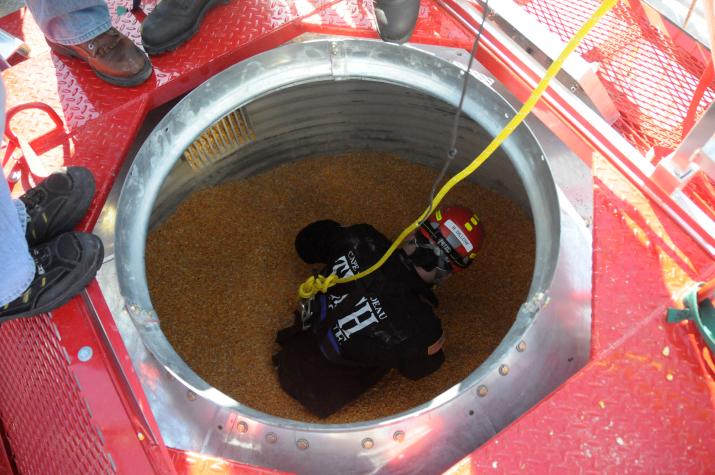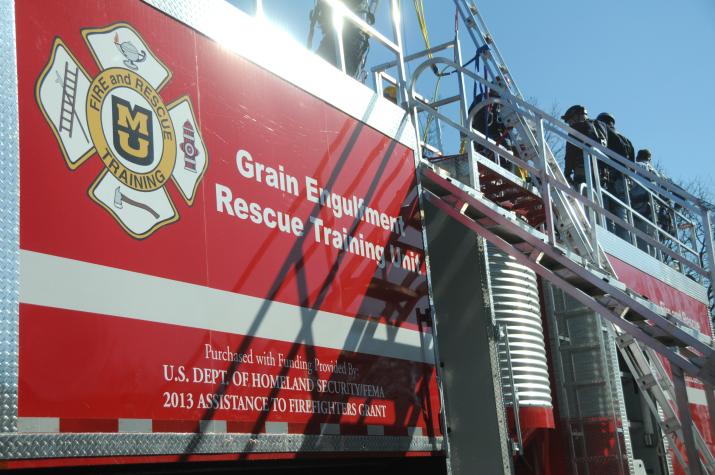MU FRTI’s mobile grain bin simulator trains firefighters.
COLUMBIA, Mo.– If you don’t work on a farm, a bin full of grain may not look dangerous. But farmworkers who go inside grain bins can quickly find themselves literally in over their heads. The results can be deadly: Over the last 50 years, hundreds in the U.S. have died from entrapment in grain, including more than two dozen in 2010, the most lethal year on record for grain bin accidents.
The good news is that training and preparation can greatly improve the odds of surviving grain entrapment, or even prevent it from happening in the first place.
To help firefighters, farmers and others learn how to safely operate in and around grain bins, University of Missouri Extension’s Fire and Rescue Training Institute (MU FRTI) has recently added a grain-engulfment rescue training simulator to its mobile training equipment roster.
The simulator includes a grain hopper, a grain bin and a station where people can learn the proper technique of cutting grain bin panels in emergencies to quickly dump grain to enable rescue.
The simulator components are installed on a 40-foot-long trailer frame, so MU FRTI can take the training program on the road. That’s an important feature, says Dave Hedrick, MU FRTI director.
About 80 percent of Missouri’s firefighters are volunteers who often lack the time and resources to travel across the state for training, Hedrick said. Rural areas especially depend on volunteer firefighters.
“We need to be able to reach those volunteers in their communities where they work and live,” he said. “Most of them have full-time jobs, so the institute conducts a substantial amount of training at night and on weekends.”
Hands-on training is important because even with help from others, escaping a grain entrapment is not easy.
“The force ranges from 325 pounds for a 165-pound person buried hip-deep in grain to more than 1,500 pounds to rescue the same person who’s 3 feet under the grain surface,” said Karen Funkenbusch, MU Extension health and safety specialist.
In March, MU FRTI tested the simulator and held a train-the-trainer session in Columbia. Twenty-four of the institute’s adjunct instructors from throughout the state went through the training. This will enable them to conduct basic grain engulfment rescue classes with the simulator, Hedrick said.
With the simulator, trainees learn about techniques and equipment to retrieve victims of grain entrapment—and avoid becoming entrapped themselves. To create an escape route, rescuers wearing tethered harnesses can surround the victim with an enclosure called a cofferdam, allowing them to remove the grain from around the victim.
Hedrick said participants in the session will form the core instructional cadre that will teach firefighters, farmworkers, grain cooperative employees and others who might find themselves working with large amounts of stored grain.
“If we can teach what to do for grain bin safety, we don’t have to do rescues,” said Marty Schuessler, a regional training coordinator for MU FRTI.
Though it’s referred to as a grain bin simulator, what happens inside it is not precisely a simulation, says regional training coordinator Robert Woody. “We put actual people in the grain bins and actually rescue them.”
As a former farm owner and retired fire chief who has seen his share of agricultural accidents, Woody is enthusiastic about the learning opportunities the simulator presents. “What an asset we’ve got right here. Unbelievable!”
The training simulator was funded through an Assistance to Firefighters grant from the U.S. Department of Homeland Security’s Federal Emergency Management Agency. To assist the institute in meeting the grant match requirement, the MU Office of Research committed to fund half the local match for the grant through its Program for Research Infrastructure and Matching Expenses. MFA Agri Services has partnered with MU FRTI to supply the grain to use in the simulator for training.
MU FRTI is charged with the responsibility of providing comprehensive continuing professional education to Missouri’s fire service and emergency response personnel. The institute has a cadre of more than 150 adjunct instructors. For more information, go to MU Fire and Rescue Training Institute (FRTI).

